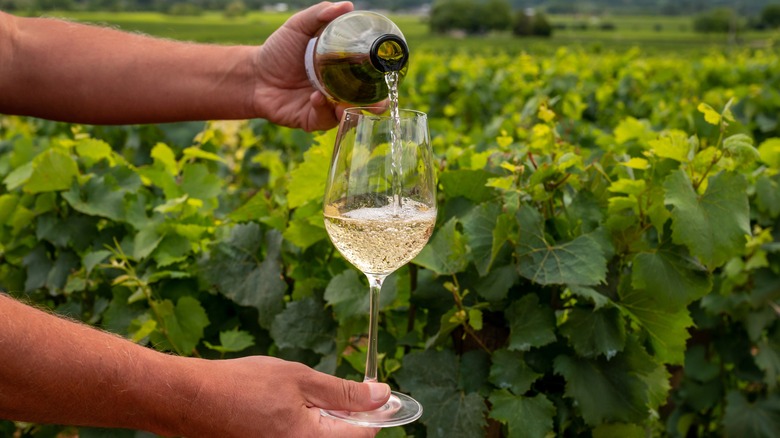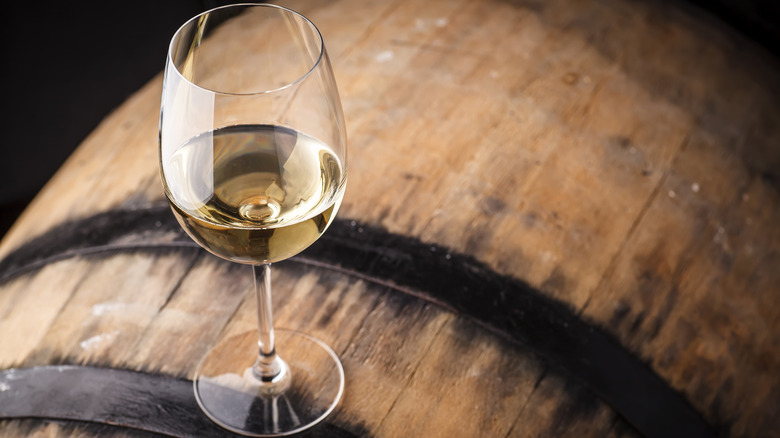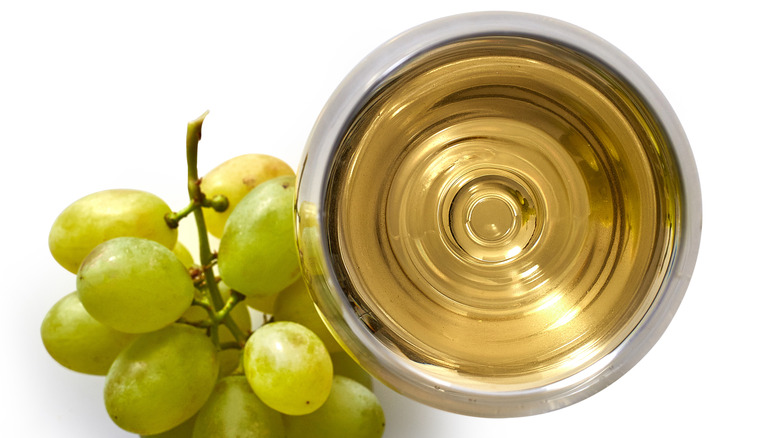Oaked Vs Unoaked Chardonnay: What's The Difference?
Chardonnay. The word alone is so ingrained in our lexicon that it's become an almost-fallback generic term for white wine. Think about it. A bartender asks, "What can I get you?" The answer is "White wine." "Chardonnay?" he asks. Unless you're a connoisseur of wine or ask for a recommendation, that's the end of the exchange. It's too bad, really. Chardonnay is much more than generic white wine. According to U.S. Wine Ratings, the history of the top-selling white wine choice in the United States is deep and complex.
Per Uncork, a DNA researcher at the University of California determined the Chardonnay grape is a cross between Gouais Blanc (an ancient grape native to what is now Croatia) and Pinot. On its own, Gouais Blanc wasn't a well-liked fruit. In fact, according to VinoMofo, it was banned in Europe at one point. But the feisty little grape persisted, eventually cross-pollinating with Pinot at a vineyard somewhere in southern Burgundy (via Uncork). The result? Chardonnay. History of Yesterday traces the genesis of this wine to a 14th-century Cistercian monastery in the French village of Mâconnais. Still, it didn't gain a wide following until the late 19th century when Chardonnay grapes were imported to California.
Let's revisit the bartender in our imaginary scenario. What if, after getting a nod from the bar patron, the bartender asked a follow-up question, "Do you like oaky or fruity?" And just like that, we're looking at a whole different conversation.
Timing is everything
According to History of Yesterday, there are two kinds of Chardonnay — oaked and unoaked. Oaked Chardonnay is aged in oak barrels, while unoaked Chardonnay is aged in stainless steel. The wine aged in oak barrels undergoes a process known as malolactic fermentation that reduces its astringency (via ScienceDirect) by converting puckery malic acid to smooth and buttery lactic acid (via Wine Folly). The result is a richer wine with notes of lemon, pineapple, yellow apple, baking spices, vanilla, and — of course — butter, according to The Grape Grind. Total Wine takes it a step further, noting how the oak used to make the barrels, French or American, can add subtle nuances to the taste, playing on notes of texture and complexity.
On the other hand, Uncork draws a line in the sand, declaring Chardonnays that lose their fruitiness have been overoaked. That was a point of contention back in the 1980s and 1990s when oenophiles began pushing back against heavily oaked Chardonnay, forming a loose alliance known as ABC, meaning Anything But Chardonnay (via Wine Insiders). Eventually, the pendulum began to swing back to fruitier, unoaked Chardonnays.
What goes around comes around
Eric Asimov, a wine critic for The New York Times, described California Chardonnay as the wine "discerning consumers love to hate" while noting that it remains the most popular grape grown in California, outpacing Sauvignon Blanc and Pinot Gris by almost 9:1. Clearly, somebody is drinking Chardonnay even as heavily oaked varieties have fallen out of favor.
Turns out the ABC movement made a lasting impression as vintners heard the call for crisper, fruitier wines with lighter, floral notes — and their adjustments resonated with wine drinkers. In the absence of layers of buttery flavor, Total Wine says unoaked Chardonnay showcases the simplicity of the grape. Wine Insiders describes it as refreshing with notes of apple and lemon and gives credit to the ABC movement for ushering in an era of more balanced and drinkable Chardonnay.
It's an interesting turn of events. According to Wine Folly, the unoaked Chardonnay we know and love today is reminiscent of French Chablis. It's a bit ironic in a what-goes-around-comes-around kind of way. Chablis is aged in stainless steel and it's made from Chardonnay grapes (via Chablis). So it turns out unoaked Chardonnay is just a new name for Chablis. Like Champagne, Chablis is a protected-status wine-making region, and France wasn't thrilled when off-shore vintners began making similar wine and calling it the same (via Wine4Food). A fuss ensued until all parties came to the logical conclusion: Change the name. And unoaked Chardonnay was born — again.


